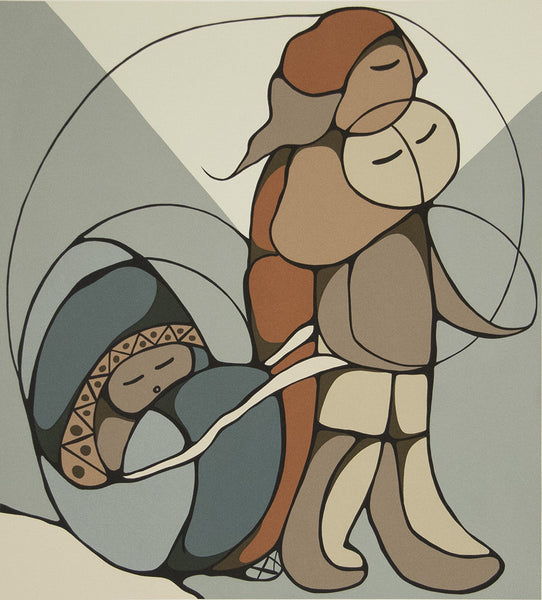Daphne Odjig
“We acknowledged and supported each other as artists when the world of fine art refused us entry…Together we broke down barriers that would have been so much more difficult faced alone.”— Daphne Odjig
Celebrated artist Daphne Odjig was born in 1919 on the Wikwemikong Reserve, Manitoulin Island. Her heritage is a combination of Odawa, Potawatomi and English roots, the Native aspects of which were revealed to Odjig as a child on sketching excursions with her grandfather. From him, a stone-carver, she learned not only the legends of her ancestors, but also the use of curvilinear design for which she has become so well known.
Odjig had painted for most of the years of her life, but it was in the 1960's that she began to exhibit a deliberately Native perspective in her work and, like her grandfather, felt compelled to try to instruct the young about their heritage. To do so, she began to focus her art-making upon the legends, joys and realities of aboriginal life, while simultaneously refining her signature style of utilizing clear colours, soft, curving contours enclosed in black outlining, transparency and overlapping of shapes and modernist, abstracted figuration.
Odjig became a founding member of the first Canadian Native-run printmaking operation, the Canadian Professional Native Artist Association, or the "Native Group of Seven" as they were described in the 70's. By this time , she was exhibiting her work several times a year, and had already gained international exposure in the United States, Europe and Japan. Her numerous awards include Honorary Doctorates of Letters from Laurentian University and the University of Toronto and more recently from Okanagan University College in June 2002, Thompson Rivers University in Kamloops in 2007, appointment to The Order of Canada, and the election to the Royal Canadian Academy of Art. In 2007, she was also given the governor's General award for Lifetime Achievement in the Visual Arts, followed by investiture into the Order of British Columbia. She also received the Award for Lifetime Achievement from the Okanagan Arts Awards in 2010. In addition, in 1978 she was presented with an Eagle Feather by Chief Wakageshig on behalf of the Wikwemikong Reserve, in recognition of her artistic accomplishments- an honour previously reserved for men to acknowledge prowess in hunt or war. Documentaries by the CBC, the National Film Board and Tokyo Television have been made about Odjig, and she's completed commissions such as those for Expo '70 in Japan, Royal Ontario Museum, and the 27-foot mural at the Museum of Civilization, "The Indian in Transition".
Highly stylized portrayals of human interaction, activities and relationships, particularly in the context of Native culture, dominate Odjig's painting, drawing and printmaking. Circular motifs predominate, signifying to Odjig "completion, perfection, and ...woman,". In her own words "As an artist and as a person I have been impressed since childhood with the process that takes us from the inner image to the external reality of an image. For me it has been an endless source of delight and wonderment that awareness, thoughts and recognitions can come seemingly unbidden from an inner source that, in adulthood, I learned to call the unconscious. I know now as an adult, that every one of us is a fusion of the eternal, of ancestral wisdom or caution as well, a seer of the future- but some part of us always remains capable of responding to here and now with originality."
Designs inspired by Daphne's work have been used to produce clothing used in the National Aboriginal Achievement Awards in March of 2003.Recently more designs from her work have been used for ties, scarves and bandanas. In 2010 a line of children's clothing called the Nanabush collection was released in conjunction with reprinting the Nanabush series of books that Daphne illustrated previously.A collection of fine women's coats and jackets have also been released.
In 2007, 2008 and 2009 shows of Daphne Odjig's works were crisscrossing North America. Forty years of her prints were being shown in Kamloops, BC and the Museum of Civilization in Ottawa, ON while forty years of her originals were being shown in Sudbury, ON, Kamloops,BC, Klienburg, ON The Institute of American Indian Art in Sante Fe, NM, Regina, SK and the National Gallery in Ottawa.
Daphne is the first Aboriginal female to have a one person show at the National Gallery. This is yet another milestone that Daphne achieved in her lifetime.
Daphne Odjig passed away in Kelowna, BC on Oct 1, 2016
Born on 1919 in Wikwemikong Reserve, Manitoulin Island, ON Canada. Died on 2016. Nationality is Odawa, Canadian
Please click here to be added to Daphne Odjig's special interest list.

Sorry, there are no products matching your search. Looking for something specific? Contact us with your inquiry.
